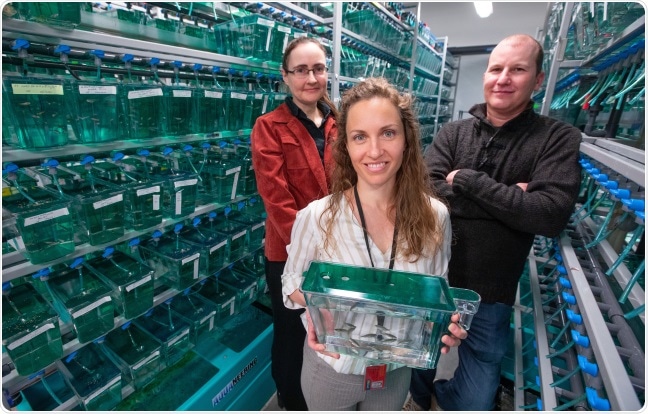For years, scientists have been unable to create a patient’s blood cells to cure blood illnesses, but a recently implemented federal funding might help IOWA State University researchers take important steps toward making that prospect a reality.

Raquel Espin Palazon (center) in the zebrafish room in the basement of the Advanced Teaching and Research Building. She is with Karin Dorman, left, and Clyde Campbell, co-investigators on a grant to study a genetic pathway that plays a critical role in the generation of blood stem cells. Image Credit: Christopher Gannon
A collaborative research team, led by Raquel Espin Palazon, an assistant professor of genetics, development, and cell biology, is investigating a genetic route triggered when cells experience inflammation due to an injury or infection.
The genetic process, according to Palazon, is also vital in the generation of blood stem cells, which are undifferentiated cells with the ability to build into all human blood cell types.
The National Institutes of Health awarded the researchers a 5-year, $2 million grant to continue their research into the mechanism in both human cells and zebrafish, and Palazon believes the findings have the potential to lead to new improvements in regenerative medicine.
Medical uses
The concept appears to be straightforward.
Patients suffering from blood illnesses like leukemia or anemia frequently require blood stem cell transplants from a healthy donor. These healthy blood stem cells can revive the patient’s whole blood system, healing the condition. However, donors are in short supply, and blood stem cell transplants remain a high-risk procedure that frequently results in inpatient problems, including death.
It would be great, according to Palazon, if doctors could create healthy blood cells from a patient’s blood and then transplant them to treat disease. To do so, the healthy cells would most likely need to be turned into stem cells, which could subsequently be transformed into whichever cell type required for treatment.
According to Palazon, scientists have yet to identify all of the molecular alterations required to carry out such transformations. Her prior research, however, revealed that an inflammatory pathway may play a key role. When cells are wounded or infected, the route triggers a response that aids the cells in fighting infection.
Blood stem cells, which are exclusively formed in the womb before birth, activate the same mechanism to produce stem cells during a critical stage of development, according to Palazon.
Focusing future studies on this pathway could lead to the creation of an unlimited supply of a patient’s particular blood stem cells that could be transplanted into the patient to cure blood diseases. She believes that creating patient-specific blood stem cells would solve the problems that come with blood stem cell transplantation.
We want to be able to understand at a molecular level what these inflammatory signals are doing. We don’t know why they are required or what they are changing in the cell to generate blood stem cells, so we’re going to try to understand that and the timing required.”
Espin Palazon, Assistant Professor, IOWA State University
It is indeed unclear what links the inflammatory pathway to stem cell generation, according to Espin Palazon, but research has shown a few indications. The mechanism, according to the researchers, preserves the stemness of cells, or the undifferentiated states that distinguish stem cells. The cells can only perform limited roles after differentiation and cannot revert to stem cells.
We think inflammatory signals are important to keep the cells in the stem-cell stage so they don’t differentiate into mature cells.”
Espin Palazon, Assistant Professor, IOWA State University
She believes that timing is an important aspect of the issue. The system is most likely activated at important periods of embryonic development to form stem cells, so scientists will have to figure out exactly when to activate it to get the necessary alterations in cells.
To answer their queries, the researchers will analyze human blood cells in a lab setting as well as zebrafish blood cells. Zebrafish make excellent model organisms, according to Espin Palazon, since their embryos are translucent and develop externally, making it possible to see their development under a microscope.